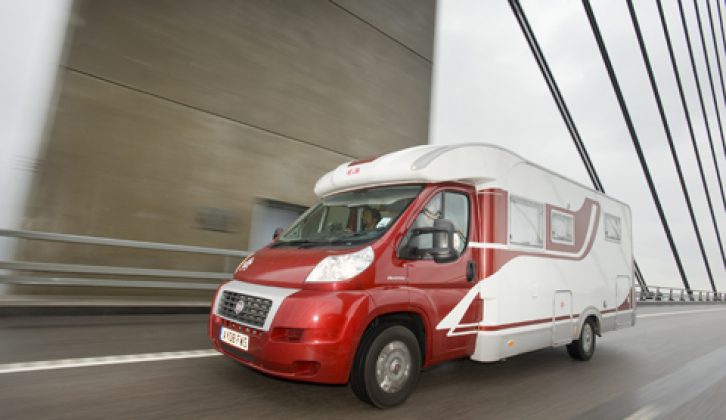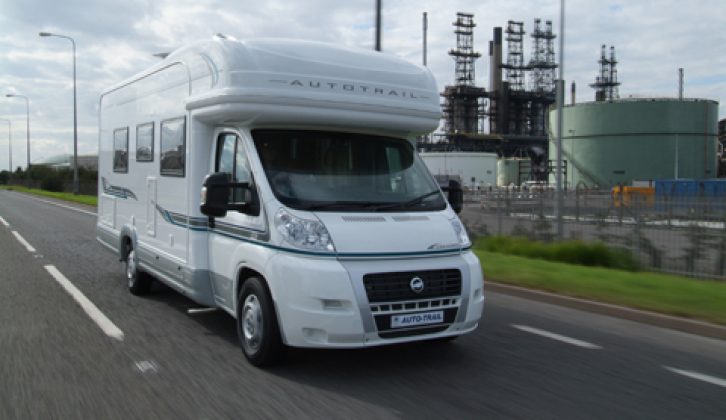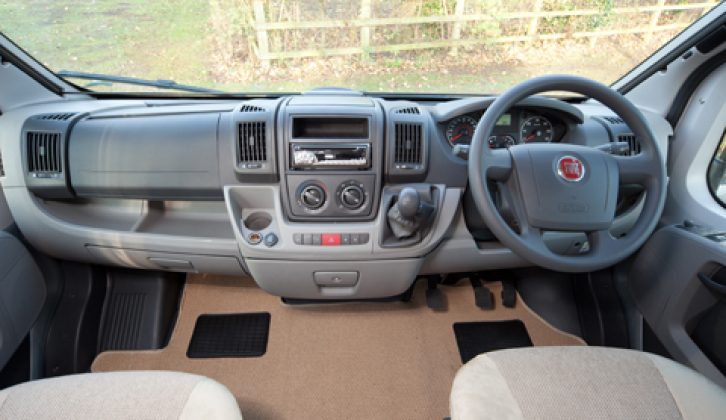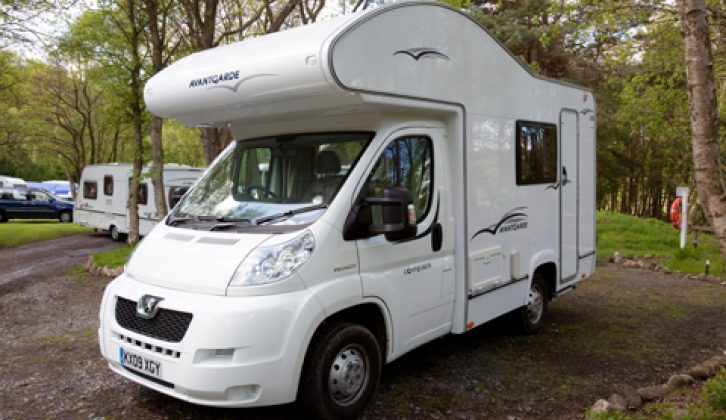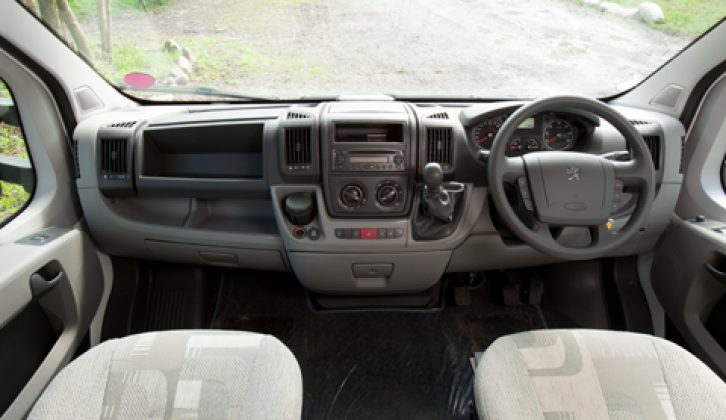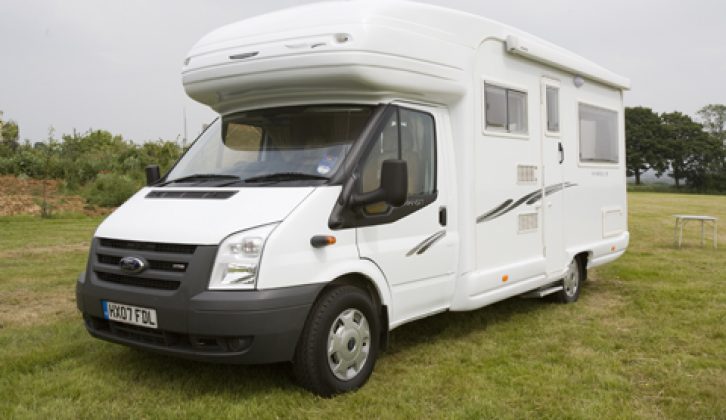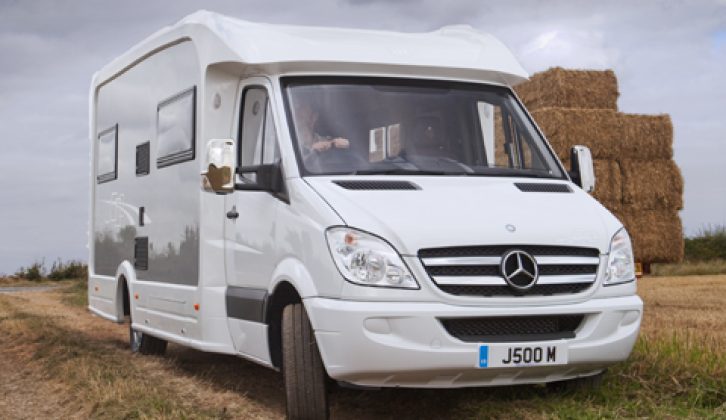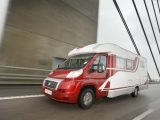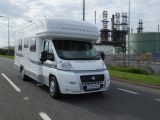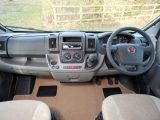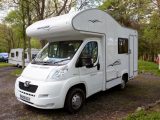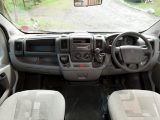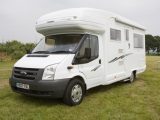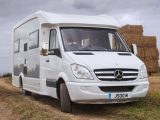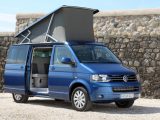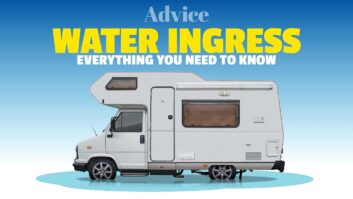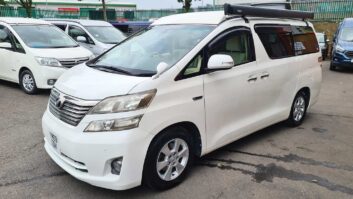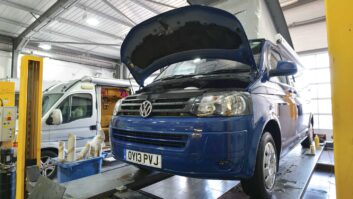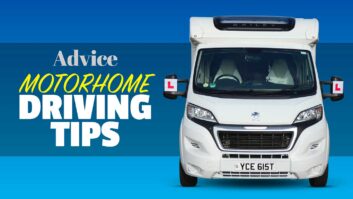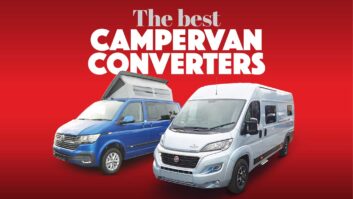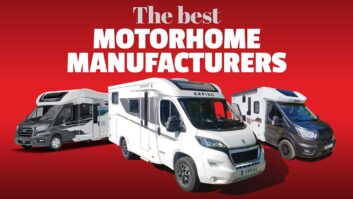Fiat Ducato
This is the most important motorhome base vehicle by far. Built at the Sevel factory in Italy, as a collaboration between Fiat and (Peugeot / Citroën parent) PSA, it’s the base for around two thirds of the European market.
There have been various versions of the Ducato. From the early 1980s until 1993, the Mk1 Ducato (also badged Talbot Express in the UK) was a very popular base vehicle. This was followed by the X230 and X244 models which were also available as Peugeot and Citroen variants, with the Talbot name being dropped.
The current version of the Ducato is the X250, launched in 2006, was the first chassis-cab to be specifically designed for motorhome manufacture.
[tl:gallery index=1 size=216×129]Available on four wheelbases, the ‘special’ motorhome chassis differs significantly from that used on commercial vehicle chassis cabs: it’s lighter, with a lower (145mm) ground clearance, and the rear track of 1980mm is wider than the standard Ducato’s 1790mm.
Not all converters use the special motorhome chassis though, instead preferring the standard version.
The most popular engine offered by motorhome manufacturers is the 2.3-litre 130 Multijet, a motorhome-only unit, which gives 130bhp and 236 lb/ft of torque. The gear ratios are ‘motorhome-specific’, with a sixth gear that improves motorway cruising. The 2.2-litre 100bhp engine is allied to a five-speed box, while the 3.0-litre 160bhp version is also available with ComfortMatic automatic transmission (at around £1500).
Fiat also offers a motorhome-specific assistance and customer service programme for the new Ducato, the only marque to do so.
[tl:gallery index=2 size=216×129]
The Ducato is renowned for its firm ride, but does offer an extremely car-like cab.
Early teething problems included water leaking into the engine bay, a problem Fiat solved by fitting an engine cover.
Of ongoing concern, though, are owner reports of vibration or ‘judder’ when reversing, most commonly reported on ’vans equipped with the 130bhp engines with a six-speed gearbox.
Various fixes have been offered, including a software upgrade to prevent stalling and produce more torque at lower revs, different engine mounts and a lower ratio reverse gear. We’ve had a number of letters from owners whose ’vans have undergone these fixes, most reporting significant improvement.
Fiat Ducatos with automatic gearboxes are available and from 2012, they have been offered with a variety of engine options.
Who builds on them?
Who doesn’t! Major volume manufacturers include Adria, Auto-Trail, Burstner, Chausson, Dethleffs, Hymer, and the Swift Group
Vital statistics
All front-wheel-drive (FWD)
• 2.2-litre 100 MultiJet
Power 100bhp @ 2900rpm
Torque 184 lb/ft @ 1500rpm
Consumption 35.8mpg*
Emissions 208g/km*
• 2.3-litre 130 MultiJet
Power 130bhp @ 3600rpm
Torque 236 lb/ft @ 2000rpm
Consumption 35.3mpg*
Emissions 212g/km*
• 3.0-litre 160 MultiJet (including ComfortMatic robotised auto-box)
Power 157bhp @ 3500rpm
Torque 295 lb/ft @ 1700rpm
Consumption 31.4mpg*
Emissions 237g/km*
*Compare CO2 emissions and fuel consumption for new van models through the VCA online database. Expect a fuel reduction of between 10-30 per cent, depending on body type and weight, when converted to a motorhome. Go to www.vca.gov.uk/vandata/vehicles.aspx.
Peugeot Boxer
Produced at the Sevel factory along with the Fiat Ducato and Citroën Relay, the Boxer is essentially a badge-engineered Ducato. It shares much similar equipment with the Fiat, with a slightly different engine line-up.
[tl:gallery index=3 size=219×129]
The Boxer is only used as a
base vehicle by a clutch of UK manufacturers and none from the Continent.
Being a twin of the Ducato, it has comparable benefits. Well set-up suspension makes it feel less like a commercial vehicle, and a range of impressive diesel engines brings refined performance plus respectable emissions and efficiency figures. However, some owners have reported issues with reverse gear vibration, as with the Fiat Ducato base vehicle.
[tl:gallery index=4 size=216×129]
All Boxers come with an impressive level of kit, with some Boxer-based motorhomes offering radio controls on the steering wheel as part of the standard specification.
Automatic versions are available with the largest engines only.
Who builds on them?
Autocruise, Auto-Sleepers, Elddis
Vital statistics
All front-wheel-drive (FWD)
• 2.2-litre HDI
Power 100bhp @ 2900rpm
Torque 184 lb/ft @ 1500rpm
Consumption 35.8mpg*
Emissions 208g/km*
• 2.2-litre HDI
Power 120bhp @ 3500rpm
Torque 236 lb/ft @ 2000rpm
Emissions 232g/km
Consumption 32mpg
Consumption 32.1mpg*
Emissions 232g/km*
• 3.0-litre HDI
Power 157bhp @ 3600rpm
Torque 295 lb/ft @ 1700rpm
Consumption 32.1mpg*
Emissions 232g/km*
*Compare CO2 emissions and fuel consumption for new van models through the VCA online database. Expect a fuel reduction of between 10-30 per cent, depending on body type and weight, when converted to a motorhome. Go to www.vca.gov.uk/vandata/vehicles.aspx.
Ford Transit
The latest generation Transit, launched in 2006 with dash-mounted gearstick, has grown in popularity with ’van manufacturers and buyers. For the 2009 season, Ford had nearly 25 per cent of Europe-wide market share.
[tl:gallery index=5 size=216×129]
The aggressive styling of the square cab ‘nose’ divides opinion, but Lutons look less bulbous than on the Ducato cab. The cab specification is superb, with some converters offering twin airbags and ESP (Electronic Stability Programme) as standard.
The Transit has a superb drivetrain, but its commercial manners are no match for the Ducato’s more refined handling.
The latest Transit offers front- and rear-wheel drive models. Many buyers love RWD, but the long prop shaft from the front of the van to the rear wheels makes fitting underfloor tanks difficult. Garage models are great load-luggers, so if you plan to tour with plenty of kit they make a lot of sense.
Who builds on them?
Big names include Auto-Sleepers, CI, Hobby and Roller Team
Vital statistics
• 2.2-litre Duratorq (FWD)
Power 84bhp @ 3500rpm
Torque 184 lb/ft @ 1500/2200rpm
Power 113bhp @ 3500rpm
Torque 221 lb/ft @ 1800-2000rpm
Power 138bhp @ 3500rpm
Torque 258 lb/ft @ 1800-2400rpm
• 2.4-litre Duratorq (RWD)
Power 99bhp @ 3500rpm
Torque 210 lb/ft @ 1600-2200rpm
Power 113bhp @ 3500rpm
Torque 229 lb/ft @ 1750-2000rpm
Power 138bhp @ 3500rpm
Torque 277 lb/ft @ 2000rpm
• 3.2-litre Duratorq (RWD)
Power 197bhp @ 3500rpm
Torque 347 lb/ft @ 1750-2500rpm
• 2.4-litre Duratorq (AWD)
Power 138bhp @ 3500rpm
Torque 277 lb/ft @ 2000rpm
*Compare CO2 emissions and fuel consumption for new van models through the VCA online database. Expect a fuel reduction of between 10-30 per cent, depending on body type and weight, when converted to a motorhome. Go to www.vca.gov.uk/vandata/vehicles.aspx.
Mercedes Sprinter
One of the reasons Sprinters are relatively rare on UK ’vans is that they are rear-wheel drive only. However, due to the high performance and kudos of the three-pointed star, Sprinters are commonly used for A-class motorhomes.
[tl:gallery index=6 size=216×129]
The models launched in 2007 were created in collaboration with VW and boasted cab changes and new engine options, with diesels all having a six-speed gearbox as standard. In summer 2009, new engines were released that comply with the Euro 5 emissions standard. They return on average 4.5mpg more than older versions, and emissions have dropped from between 232-304g/km to 214-264g/km.
One advantage of the Sprinter is its high specification, including the option of a full automatic gearbox and adaptive ESP as standard.
Its cab is arguably the most stylish of all the available base vehicles, with wood-effect trim and the convenience of a fold-down handbrake, which helps the cab seats swivel more easily.
Who builds on them?
Concorde, Dethleffs, Devon Conversions, Esterel, Frankia, Geist, Hymer,
IH, La Strada, Marquis Motorhomes, Rapido, Rimor
Vital statistics
All rear-wheel-drive
• 2.1-litre turbodiesel
Power 95bhp @ 3800rpm
Torque 184 lb/ft @ 1400-2400rpm
Consumption 31.0mpg*
Emissions 240g/km*
Power 129bhp @ 3800rpm
Torque 225 lb/ft @ 1200-2400rpm
Consumption 33.6mpg*
Emissions 222g/km*
Power 163bhp @ 3800rpm
Torque 266 lb/ft @ 1400-2400rpm
Consumption 34.9mpg*
Emissions 214g/km*
• 3.0 litre turbodiesel
Power 190bhp @ 3800rpm
Torque 440 lb/ft @ 1400-2400rpm
Consumption 28.3mpg*
Emissions 264g/km*
*Compare CO2 emissions and fuel consumption for new van models through the VCA online database. Expect a fuel reduction of between 10-30 per cent, depending on body type and weight, when converted to a motorhome. Go to www.vca.gov.uk/vandata/vehicles.aspx.
Volkswagen Transporter (T5)
An ever-popular base for van conversions, less so for coachbuilts. The fifth-generation Transporter (T5) was introduced in 2003 and was face-lifted in 2009.
Volkwagen has a rich heritage of camper conversions. The T2 ‘bay window‘ bus is an iconic vehicle, while its successor, the T25 (T3 in the USA) is attracting similar levels of interest. Conversions built on the T4 model, built between 1991 and 2003, have very strong residuals too.
[tl:gallery index=7 size=216×129]The FWD Transporter has a dash-mounted gearstick and ABS as standard, and the driving position is praised for its level of adjustment.
Many of the motorhomes currently available offer the popular 1.9 TDI diesel engines. Four new 2.0-litre TDI engines, with power outputs of 84PS, 102PS, 140PS and 180PS, will be available in the UK as Californias or Kombis from early 2010.
Manual and autos are available, with the dual-clutch seven-speed DSG system fitted to the 140PS and 180PS engines.
Who builds them?
Auto-Sleepers, Bilbo’s Design, Danbury, Devon Conversions, Karmann, Leisuredrive, Middlesex Motorcaravans, Murvi, Reimo
Vital statistics
VW Transporter 1.9-litre TDI
Emissions: 224g/km
Consumption: 33mpg
*Compare CO2 emissions and fuel consumption for new van models through the VCA online database. Expect a fuel reduction of between 10-30 per cent, depending on body type and weight, when converted to a motorhome. Go to www.vca.gov.uk/vandata/vehicles.aspx.
Best of the rest
Two famous French marques account for a small number of sales in the UK: Renault’s Master and Trafic vans, and Citroën’s Relay and Berlingo. You’ll find Renault Masters on Adria’s A-class Vision for example, plus van conversions from Danbury, Timberland and Devon.
Citroën vans are almost exclusively used for conversions, with Nu Venture Motorhomes and Romahome predominantly using the 1.6 HDi Berlingo. These have five-speed gearboxes available in manual or auto specification. Wildax builds its ranges on the larger Relay, using the 2.2 Hdi engine with a six-speed gearbox.
Another niche base vehicle with a loyal following is Iveco, which tend to be used for larger motorhomes as their chassis are plated to carry large maximum weights. Concorde, the luxury high-end manufacturer, uses Iveco Daily and Eurocargo chassis, which have huge maximum weights between 4200kg and 8600kg with meaty payloads. Concorde is the only manufacturer that builds on MAN vehicles, with maximum weights of 10,000kg. Other motorhomes built on Iveco include Hobby’s Sphinx range and the two Hymer Liner vans.
Autocruise builds the little Pulse on the Fiat Scudo and Danbury uses the tiny Fiat Doblo.
And you can buy retro-looking VW campervans based on brand new, Brazilian built VW Type 2 bay window, converted by Danbury.
Only ever available used in the UK, the Mazda Bongo is available in relatively large numbers on the second-hand market. Also badged as a Ford Freda, many of them are four-wheel drive, automatic and diesel powered. There is a lot of information on buying these narrow-bodied campers here.
